Jan's Working with Windows 10:
Glossary
If you don't see the term you are looking for, use your browser's Find command to search for it. Perhaps your term is used in a definition.
# or symbol
A B C D E F G H I J K L M N O P Q R S T U V W X Y Z
# or symbol
- 8.3 name
- A file or folder name in MS-DOS style, with 8 characters then a dot and then 3 more characters.
A
- active window
- The window which will receive keystrokes. The Title bar is normally a different color from the inactive windows.
- Address bar
- In a browser-based window (including File Explorer), the Address bar contains the Address text box, where you enter the
URL or path to what you want to see. This bar may contain other buttons such
as Back and Forward or Up one level.

- adjacent
- Next to each other.
- Aero
- A set of graphics features for Windows Vista & Win7, including transparent glass effects and subtle animations for windows, Flip 3-D arrangement for open windows, preview popups for task bar buttons.
- Align to Grid
- A feature of views of files and folders, except the Details view, which lines up icons to the nearest invisible grid line. Not the same as AutoArrange.
- Appearance
- A tab on the Display Settings dialog which controls the look of the Desktop and windows, including the colors and fonts used.
- app or application
- A software program
- Apply button
- In a dialog box, a command button
 that applies the changes you made but leaves the dialog box open
that applies the changes you made but leaves the dialog box open - arrangement
- The way the icons are placed on the desktop or in a window.
- associated
- A file format is associated with a program that can open that type of file. Double-clicking a file in a files-and-folders window will open the file in that program.
- AutoArrange
- Icons are automatically lined up in neat rows and columns. This is not the same as sorting, which arranges the icons based on a particular property, like file size or date. Not the same as Align to Grid.
B
- Back button


 A button which returns the window to the previous page, found in browsers and search windows and File Explorer.
A button which returns the window to the previous page, found in browsers and search windows and File Explorer. - background
- What shows behind/underneath text or icons.
- backspace
- Using the BACKSPACE key on the keyboard erases the character to the left of the cursor.
- backup
- Making a copy of files is "backing up" the files. The copy is a "backup".
- bitmap
- A format for images which specifies the color of each pixel in the image separately.
- bookmark
- 1. A particular spot on a page that is marked with code so that a link
can jump right to that spot.
2. A shortcut in a browser that opens a web page. Internet Explorer calls these Favorites. - boot
- To turn on the computer and start the operating system.
- bootable disk
- A removable disk which has on it the system files needed to start the computer. You can use such a disk to boot the computer when the hard disk has failed or some other problem prevents the operating system from working.
- boot drive
- The drive that holds the operating system.
- branch
- A portion of the folder tree which contains other folders and files
- bread crumbs
- A way to show you where you are in a set of organized pages, like
Home > Products > Computers > Prices.
Each level is usually a link to make it easy to navigate back up to higher levels. - browse
- To navigate through various parts of the folder tree or web pages.
C
- Cancel button
- In a dialog box, a command button
 that closes the dialog without applying any changes
that closes the dialog without applying any changes - canvas
- The area in which you can draw in a graphics program like Paint.
- cascade
-
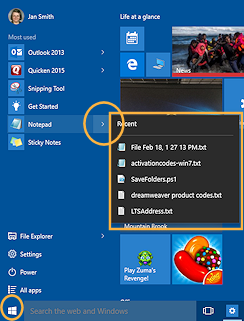 One flowing out of another, such as menus within menus.
The Start menu and program menus can both cascade. The illustration shows the Start menu with a cascading menu of recent files for Notepad.
One flowing out of another, such as menus within menus.
The Start menu and program menus can both cascade. The illustration shows the Start menu with a cascading menu of recent files for Notepad. - check box
- In a dialog box, an input box
 that is either checked or unchecked
that is either checked or unchecked - click
- The action of pressing down a mouse button (usually the left one) and releasing it.
- clipboard
- A temporary area of memory that Windows sets aside for material that you copy.
- Close button
- The small button like
 on a window's Title bar which, when clicked, closes the window.
on a window's Title bar which, when clicked, closes the window. - color depth
- The number of colors that a monitor can display. Depends also on the video card being used. Values include 256, 64,000+ colors (called High Color or 16 bit color), 16 million+ colors (24 bit color), 4 billion colors (True Color or 32 bit color)
- color palette
- The colored squares on the ribbon in Paint which are the colors available to use.
- collapse
- To hide the nested folders in a branch of the folder tree.
- command button
- In a dialog box, a button like
 which, when clicked, executes a command.
which, when clicked, executes a command. - computer
- An electronic device that takes input and processes it to produce output, which it then stores.
- Contents
- In a Help dialog, the tab or pane with the list of topics.
- Contents pane
- In a File Explorer view of drives, files, and folders, the pane on the right is the Contents pane and shows the contents of what is selected on the left in the Navigation pane.
- context menu
- A menu that opens with a right click of the pointing device. What is listed depends on what was clicked and what you were doing.
- context-sensitive
- Varies depending on the context.
Ribbon tab: A tab that shows when a particular type of object is selected.
Context menu: A right-click menu that shows different commands depending on where the right click occurred.  contextual tabs
contextual tabs- Tabs on a ribbon that show only when a particular type of object is selected. For example, Picture Tools: Manage appears only if a picture is selected.
- control icon
- An icon at the top left of a window which opens a menu of commands that control the window's size and position.
- control menu
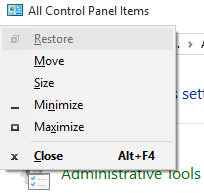 A menu that appears when you click the far left of the Title bar. It
contains commands to control the size and location of the window.
A menu that appears when you click the far left of the Title bar. It
contains commands to control the size and location of the window. - Control Panel
- A special window that contains icons for a variety of tasks, such as
adding and removing programs from the computer, configuring hardware, and
changing the appearance of the Desktop and windows.
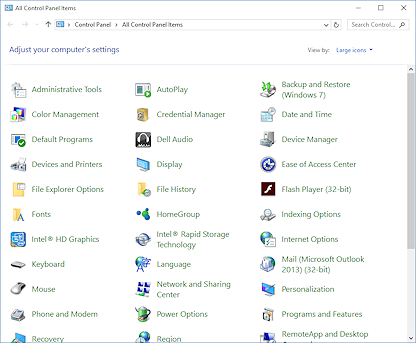
- Cortana
- The new personal assistant that comes with Windows 10. If your computer has a microphone, like many tablets and smartphones do, you can even talk to Cortana and ask questions. Cortana is the feature that uses Windows Search to find things on your computer and on the web.
- copy
- To copy the selected material to the Windows clipboard to use it somewhere else without removing it from the original location.
- Copy Disk
- A command which copies an entire disk to another disk.
- crash
- A crashed computer has lost its mind. It can no longer function. Crashes can be caused by hardware failure and by software.
- criteria
- The rules by which you judge or measure. Criteria for filtering set the characteristics that must be matched for that object to be included.
- crop
- Cutting off parts of an image to reduce its dimensions.
- CTRL+ALT+DELETE
- A key combination. Hold the CTRL key and the ALT key down at the same time and press the DELETE key. In old versions of Windows this combo restarts the computer. In more recent versions, it opens the Task Manager, or a list of options that includes the Task Manager.
- cursor
- A symbol (usually a vertical line or I-bar) which shows where your typing will appear on the screen
- customize
- To change settings from the original (default) ones.
- cut
- To remove the selected material from the document. It is copied to the Windows clipboard and can be pasted somewhere else.
D
- default
- The original setting; what happens if you do not change the settings.
- delete
- To remove something; erase.
- demo
- A demonstration, usually with animation and audio, of how something works or of how to do a task.
- Desktop
- The area above the Taskbar on your screen.
- destination
- The disk or drive that you wish to receive what you are copying or moving.
- Details pane
- A pane at the right of the File Explorer window. The pane displays information (details) about what is selected.
- Details view
- Shows the file properties across the window, like Name, Size, Type, Date modified.
- diagonal resize
- The shape of the pointer,
 or
or  , when dragging will resize the window in both directions at the same time.
, when dragging will resize the window in both directions at the same time. - dialog
- A window with command buttons and input areas like text boxes, drop lists, and radio buttons.
- directory
- Same as a folder.
- disc, disk
- A circle of recording material, which is metal for hard disks, Mylar for floppy disks, a complex set of plastic and metal layers for CDs and DVDs. This word is sometimes applied generically to any recording material, whether circular in shape or not.
- Display Settings
- A dialog that controls the look and behavior of many aspects of your Desktop and windows, including the color depth, screen resolution, and appearance of windows.
- dock
- To fix a window or toolbar in a specific position. A window can be docked to the left, right, or top side of the Desktop in Windows 10. A toolbar may be able to be docked inside a window to one of the four edges.
- document
- Primarily what a word processing program like Word produces, such as a letter or report, but can also be a spreadsheet, image, sound byte, or any other file that provides information to the viewer/listener.
- double-click
- Clicking twice quickly.
- drag
- Moving the mouse while holding down a mouse button.
- drive
- A device which contains recording material. A floppy disk is inserted into a floppy disk drive. A hard disk is inside a hard disk drive. A USB flash drive contains one or more flash recording chips.
- drop
- Part of drag-and-drop, which is a way to move or copy objects by dragging with the mouse. When your object is in the location where you want it, you release the mouse button to drop it there.
- drop list
- A dialog input which hides a list of options until you click on the arrow. Then the list appears.
E
- edit
- To make a change in an existing document. You might add to it, delete part, or move parts within the document.
- eject
- To make a removable disk like a CD or DVD come out of the drive. Also, to make a USB flash drive ready for removal.
- expand
- To show the previously hidden material, such as folders and files that are nested inside a branch of the folder tree or sections of an HTML page or a Help page.
- Explorer
- A window which shows the folder tree as well as the contents of what is selected in the folder tree.
- extension
- The part of a file's name that follows the dot. filename.extension Most extensions are 3 characters long. Some are 4 characters, like .html for some web pages.
-
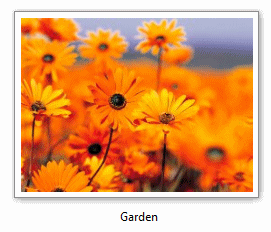 Extra
Large Icon
Extra
Large Icon - A very large size icon for a file or folder. Especially useful for images. Arranged alphabetically across the window.
F
- Favorite Links
- Links shown above the folder tree in the Navigation pane of a File Explorer window.
- Favorites
- A set of shortcuts to web sites, folders, or files that you use often.
- filename
- The first part of a file's name, which comes before the dot. filename.extension Under Windows after Win95, this first part can be very long and can contain spaces.
- file
- A file is a single item that can be stored or executed or opened with a program. (Getting down to the most basic ideas here!)
- File Explorer
- The name for the window that displays disks, folders, and files.
- file type
- The file extension indicates what the file's type is - Word document (.doc, .docx), Paint picture (.bmp, .png, .gif), executable that runs a program (.exe)
- filter
- To show only the objects that meet the criteria you have picked, such as showing only image files or only files created on a certain date.
- Find dialog
- A dialog which lets you search on a particular page for a specific word or phrase.
- flash drive
- A removable drive that connects to a USB port on the computer.
- floppy disk
- A removable storage medium. Consists of a Mylar disk with magnetic properties inside a hard plastic case. Obsolete.
- folder
- A grouping of files in the folder tree
- folder tree
- A graphical display of the relationship of the folders and drives on a computer with collapsible sections.
-
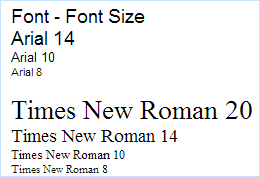 font
font - A set of characters with a similar look for creating documents.
- font size
- The size of the characters. Different fonts may show different physical sizes for the same 'font size'.
- format
- To prepare a storage disk for use. Formatting erases all previous data, sets up an area to list what is stored where, and checks for physical and magnetic damage.
- frozen
- When a computer display is frozen, the computer ignores whatever you do. Moving the mouse or pressing keys does not change the display. This can be temporary if the computer's processor is busy with an intense task. Or, the computer may be caught in a logical loop. In that case, restarting the computer may be the only way to get the computer to pay attention to you again.
- full format
- A full format does all three tasks in the "format" definition.
G
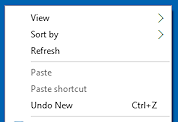 grayed out
grayed out- The colors are dimmed on a
menu, button, or icon for a command
that is currently not available. The illustration has black text for available commands and gray for unavailable commands.
- Group By
- A way of arranging icons in a File Explorer window by putting objects with similar characteristics together. You can group by name or date created or date modified or file type, for example.
- GUI
- Graphical User Interface: a method for allowing users to interact with a computer by using pictures instead of typing in text commands.
H
- handle
- A small shape (usually square) at a corner or in the middle of an edge which resizes the object when you drag it.
- hard disk
- A set of metal platters inside your computer which stores your operating system, programs, and data files. A hard disk can be partitioned into several logical drives, which appear separately in the folder tree. This is necessary on some computers to get around the limitations that the operating system puts on the size of a hard disk. It can also make it easier to maintain the disk.
- Help
- A window which has explanations and tips about your operating system or application.
- hibernate
- A low-power state for a computer. Open documents are saved to the hard disk.
- History
- A list of actions taken or pages visited.
- Home
- The first page of a web site or other organized set of pages.
- horizontal resize
- The shape
 that the pointer takes when dragging will change the size of the window horizontally.
that the pointer takes when dragging will change the size of the window horizontally. - hover
- When you let the pointer
 stay over a particular object or location
stay over a particular object or location - hyperlink
- See link
I
- icon
- A small image that represents a program or action or document.
- inactive window
- A window which is open but which will not receive any of your keystrokes.
- Index
- The tab or pane in a Help window which has an alphabetical list of keywords and phrases
- Indexed locations
- Parts of your computer that Windows automatically indexes to speed up searching. The Search box on the Taskbar and at the top of a File Explorer window look in Indexed locations by default. Unindexed locations take longer to search the contents.
- insert disk
- To put a CD, DVD, floppy disk, Zip disk into its drive. Also used sometimes for connecting a USB drive to its connector.
- interface
- The point of contact for communication or physical exchange between different systems. A user interface allows people to interact with a computer program or a machine.
J
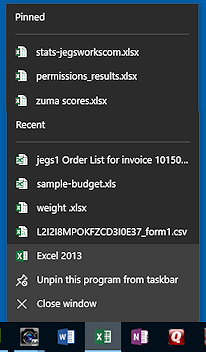 jump list
jump list- A list of documents that pops up when you right click the thumbnail of an open application on the Task bar. The illustration shows a MS Excel button on the Task Bar with its jump list above it.
K
- keywords
- Words which pick out the important ideas in a section of writing. Keywords
can be used in a search to find the document.
L
-
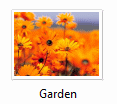 Large Icon view
Large Icon view - An arrangement of icons in a Computer or File Explorer window that uses a larger icon. Arranged alphabetically across the window. Images and some documents will display a thumbnail image.
- Layout
- The arrangement of bars and panes in a window.
- left click
- Pressing the left mouse button and then releasing it.
- Library
- A group of folders of similar materials, especially documents, pictures, music, and videos. Such files can be stored in different locations but be listed in the same library. A custom library might group the files for a particular project.
- link
- A word or phrase which can be clicked on in a browser to open another page, document, or image. Also called hyperlink.
- list box
-
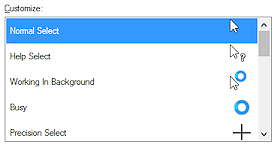 In a dialog box, an input which lists all of the options that you can choose. There is a scroll bar if there are too many items to show at once in the space allowed.
In a dialog box, an input which lists all of the options that you can choose. There is a scroll bar if there are too many items to show at once in the space allowed. - Live Preview
- Temporarily shows the effect of changes while you are making choices. This allows you to see the effect of your choices before actually applying them.
- List view
- An arrangement of icons in a Computer or File Explorer window that uses small icons and alphabetizes down the window
- lock
- 1. lock a computer: Puts a screen saver or other page on the
monitor. You must login to get access to the
computer again. The computer remain on and your open applications and
documents will be there when you log back in.
2. lock the Taskbar: Keeps the Taskbar from being moved and does not allow the Notification Area to be resized. - logical drive
- A hard disk can be divided into several logical drives, which the computer treats like they were actually separate pieces of hardware. Dividing a hard disk up like this is necessary when the hard disk can store more data than the operating system can manage in one lump.
- log off
- Also log out. To exit a web site or a session on a computer or network in such a way that to gain access again, you must log on again, entering your user name and password.
- log on
- Also logon, log in, or login. To enter your user name and password to gain access to something, such as a computer, a web site, a document, or a network.
- long file name
- A name for a file which has more characters than 8.3.
M
- marquee
- A dashed or dotted box outline surrounding an object or objects. In some programs a marquee blinks.
- marquee select
- Dragging the pointer across several items selects them and surrounds them with a dashed box, the marquee.
- maximize
- To make a window take up all of the available space. The Maximize button
 is on the window's Title bar.
is on the window's Title bar. - Medium Icon view
-
 An
arrangement of icons in a Computer window that uses a medium size icon.
Arranged alphabetically across the window.
An
arrangement of icons in a Computer window that uses a medium size icon.
Arranged alphabetically across the window. - menu
- A list of available commands.
- Menu bar
- A bar, usually across the top of a window below the Title bar, which contains menu items, which may be menus themselves.
- minimize
- To reduce a window to an icon on the Taskbar or at the bottom of an application window.
The Minimize button
 is on the window's Title bar.
is on the window's Title bar. - mouse
- A type of pointing device which fits under the user's hand and has buttons for clicking.
- move
- Change locations in the folder tree or on the screen.
- MS-DOS format name
- Another name for 8.3 format.
N
-
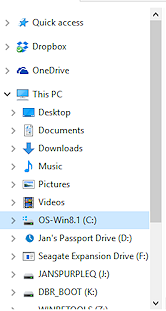 Navigation
pane
Navigation
pane - In a window that shows drives, folders, and files, the pane on the left that shows the folder tree. In recent versions of Windows, this pane also shows Favorite Links at the top. Files are not shown in the Navigation pane.
- nested
- One inside the other.
- non-adjacent
- Objects that are not right next to each other.
- Notification area
- On the Taskbar, the area at the right which holds the clock and icons for other background applications. Also known as the Tray.
O
- OK button
- In a dialog box, a command button
 which, when clicked, accepts any changes that you made and closes the dialog.
which, when clicked, accepts any changes that you made and closes the dialog. - offline Help
- Help articles which are stored on the computer's hard disk and were installed with the operating system or program.
- online Help
- Primarily, Help articles which are stored on a web server. You must have an Internet connection to see the articles. Other kinds of help that require an Internet connection may be considered online Help, such as help by email or through a chat window or by remote control.
- open
- 1. To start a program, like Paint or Notepad.
2. To make visible a window, like the Control Panel.
3. To display a document in an appropriate program. - option button
- See radio button.
- options
- Choices; settings that you can change
P
- Page Setup
- A dialog in which you can set choose how a printed page will look, including margins, page orientation, headers, footers.
- palette
- A set of options, like colors for a font or shapes for a drawing object.
- pane
- A portion of a divided window.
- paste
- To take material previously copied to the Windows Clipboard and put it in a document or, similarly, to place a whole file in a new location after copying it.
- path
- The list from drive to file of the nested levels to a file, like
C:\Program Files\Office\winword.exe - pattern
- A design that can be repeated across the desktop as a decoration.
- personalize
- Another term for customize. Making changes from the defaults, especially to the way Windows or a program looks.
- pin
- To fix in place. When you pin a program to the Taskbar, its icon shows all the time. When you pin a document to a jump list, the name of the document shows in the jump list all the time.
- pointer
- The symbol for the location which will receive your clicks.
- pointing device
- A device which controls the pointer, such as a mouse, touchpad, or graphics tablet.
- popup menu
- A menu which appears when you right click on something.
- preview
- 1. To see what something will look like before actually applying your
choices.
2. To see how a document will look before printing it
3. To see a small version of an image or document before opening it. - 1. To put the file contents onto paper with a printer
- 2. A dialog which contains choices for how much to print, how many copies, color or not, which printer to use.
- Print Preview
- A display of a document as it will appear if you print it.
- Properties
- A command on a menu which will open a display of the characteristics of the object. You may be able to change some of the characteristics.
Q
- Quick Access bar
- In the Navigation pane of a This PC or File Explorer window, the section at the top holds shortcuts to drives and folders that you use often.
- quick format
- Formatting a disk without checking the disk for physical or magnetic errors.
R
 radio button
radio button - In a dialog box, an input which is either selected or not. Only one radio button in a group can be chosen.
-
 Recycle
Bin
Recycle
Bin - A special area that saves objects that you have deleted until you empty the Recycle Bin or it gets too full to hold anything else. Then objects are deleted as needed to make space for the new deletions, starting with the oldest objects. You can easily restore items that are still in the Recycle Bin.
- redo
- Reversing an action that you just used the Undo command on.
- refresh
- Forcing the computer to look again and display the most recent information. The F5 key is often assigned as a shortcut for this action.
- removable media
- Storage media that can be removed from its drive and taken to a different computer or stored away safely. Includes writable CD or DVD discs, floppy disks, USB drives, Zip disks and similar products.
- rename
- To change the name of a file or folder.
- resize
- To change the size of a window or image.
- resolution
- The number of pixels that a monitor can display (width x height), such as 640 x 480, 800 x 600, 1024 x 768, 1280 x 1024. The higher the number, the finer the detail that can be shown.
- restart
- To close all programs and turn the computer off but then automatically start the computer again.
- restore
- To return a window to its previous size. The Restore button
 is on the window's Title bar.
is on the window's Title bar. - ribbon
- Commands are on a tabbed ribbon, which
combines buttons, drop lists, palettes, and dialogs to make commands easier to find
and implement. The ribbon was introduced in Windows 7.

- right click
- To press and release the right mouse button.
- right drag
- Right click and then drag while still holding down the right mouse button.
- root
- The top level for files and folders on a drive.
S
- Safely remove hardware
- A small program that closes down a removable drive or other USB hardware so that it can be disconnected without damage to the files or the device.
- Save
- To record the current state of a file so that changes are not lost.
- Save As
- A command which brings up a dialog so that you can save the document with a new name, with a new file type, or in a new location.
- screen saver
- A sequence of images that appear when the monitor has been idle for a set amount of time. It's purpose is to keep old monitor screens from being damaged by having the same image on the screen for a long time. For modern screens a screen saver is just eye candy.
- screen shot/screen capture
- An image of what is on a computer screen. Pressing the key PrtScn sends a copy of the screen to the Windows Clipboard. The key combo ALT + PrtScrn captures an image of just the active window. You can paste this image into a document or into a graphics program like Paint for editing.
 screen tip
screen tip- A small message that appears when the pointer
 hovers over
something like a button or icon.
hovers over
something like a button or icon. - scroll arrow
- The arrow button at the end of a scroll bar. Clicking the arrow moves the contents of the window by a small distance.
 scroll bar
scroll bar - Used to change what part of a document is showing in a window when it is too large for all of it to fit.
- scroll box
- The box on the scrollbar which you can slide to move the document in the window.
- scroll wheel
- A small wheel on a mouse, usually between the left and right mouse buttons. Turning the wheel performs the same action as using the scroll box in a window.
- Search
- 1. Search box: A text box in a window in which you type keywords or
phrases in order to find documents that contain them.
2. Windows Search - Windows 10: Using Cortana by voice or with the Search box on the Taskbar, results from apps, folders, files, settings, and web sites. - select
- To click on an object or a choice in a dialog to make it the object of your clicks or keystrokes.
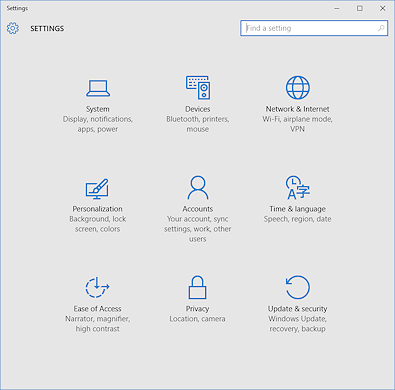 Settings
Settings- A set of pages where you can make choices about how Windows behaves. Some settings are still in Control Panel dialogs.
- shortcut
- An icon or key combination which executes a command, such as to open an application or a document.
- shut down
- To close the running programs and turn off the computer.
- Sleep
- A low-power state for a computer. In most computers, open documents are
saved only to memory, not to the hard disk, while in the Sleep state.
 slide
slide - In a dialog box, an input which changes a value based on how you drag a sliding box.
- slide switch
- A small slide that only has two options, On or Off.


- Small Icon view
-
 In
Windows Vista and Win98, an arrangement of icons in a Computer window which uses smaller icons and alphabetizes across the window.
In
Windows Vista and Win98, an arrangement of icons in a Computer window which uses smaller icons and alphabetizes across the window. - snap window
- Moving a window to the top, left or right sides of the screen will snap it in place, docked at that edge. At the top the window will maximize to fill the whole screen. At the left or right the window resizes to fill half the screen. The same effect can be done by combining the Windows key and a directional arrow key.
- sort
- To arrange items in an order based on a property, like Name or Date modified.
- source
- The disk from which you want to copy or move files or folders. You move them to a destination disk.
- spin control box
-
 In an dialog box, an input which shows only one value at a time. To change values you use up/down arrows. Most spin boxes also let you type a value.
In an dialog box, an input which shows only one value at a time. To change values you use up/down arrows. Most spin boxes also let you type a value. - Stand by
- A low-power state for a computer, usually a laptop.
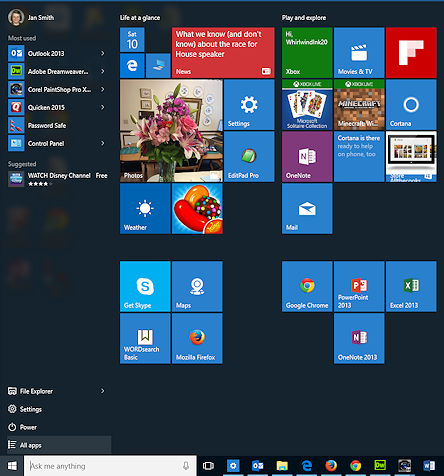 Start menu
Start menu - A button on the Taskbar which displays a list of commands or other menus. The Windows 10 Start menu is different from previous Start menus. The tiles on the right are for apps that are pinned to the Start menu.
- Status bar
- A bar at the bottom of a window which shows text or icons that reveal the status of various processes. For example, the Status bar of a word processing program might show the position of the cursor by line and character position. An icon might show whether the CAPS LOCK key was on.
- stretch
- Resizing an image to fit the space, such as to cover the whole screen as wallpaper
- subfolder
- A folder contained in another folder.
- Switch User
- One of the options in the User menu. If you just switch to a different user account, when you switch back, all of the programs and documents that you left open are still open.
- system disk
- A bootable disk, which is one that can be used to start up a computer.
T
- tab
-
Dialog tabs:A section of a window which acts like the tabs on file folders. Clicking on a tab label brings that portion of the dialog or ribbon to the front so you can see it.

Ribbon tabs:
- Tablet Mode
- This mode lets Windows 10 use an interface that is actually intended for tablets and smartphones. Apps do not run in a window but full screen. Instead of a normal Start menu, you see the tiles for pinned programs, similar to the Start screen for Windows 8.
- Taskbar
- At the bottom of the Windows screen, it contains the Start button, icons for open applications, the Quick Launch area, and the Tray or notification area.
-
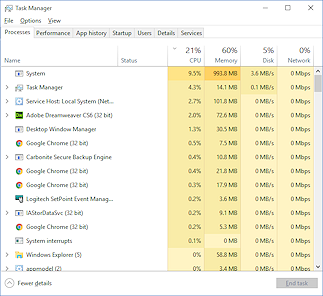 Task Manager
Task Manager - A dialog which lists all the currently running tasks on the computer. You can terminate each one separately. The Performance tab helps you see what apps or processes are using too much memory, bandwidth, etc.
- text box
-
 In a dialog box, an input in which you must type.
In a dialog box, an input in which you must type. - text editor
- A simple program for writing basic text-only documents.
- texture
- A small image file that is used as a background pattern and is repeated across the screen. A texture can create the illusion of fabric or metal or grass, for example.
- theme
- A collection of appearance choices, including background, colors, and sounds.
- This PC
- The new name for the icon or File Explorer item that represents what is on the current computer. Previously this was called Computer or My Computer.
- tile
- Start menu: A square or rectangle holding an icon for an app in the right side of the Start menu for Windows 10.
Background: A small image and is repeated going across and/or down to cover the background of the Desktop or a web page. -
 Tiles
View
Tiles
View - A view of files and folders that shows some details about the object beside the icon for it.
- Title bar
- The bar at the top of a window which shows the title of the current document, the name and icon for the program, and window control buttons (Minimize, Maximize/Restore, Close).
- tool
- A button in a program like Paint that changes the behavior of the pointer. For example, the text tool in Paint changes the pointer to draw a box for writing text in the picture.
- toolbar
- A bar of buttons for commands, usually grouped by use. Most programs now use a ribbon.
- topic
- In a Help window, a category for Help documents
- Tray
- See notification area.
U
- unavailable command
- A command which cannot be used at this time. Usually this means that the command cannot be applied to what is currently selected or has the focus.
- undelete
- To undo a deletion, returning everything back to the way it was before you deleted.
- undo
- To reverse an action. Undo applied to typing would erase the characters you typed. Undo applied after deleting a folder would restore the folder.
- user interface
- The way people interact with the software. A graphical interface uses images like buttons and windows. A text interface uses typed commands.
V
- vertical resize
- The shape
 that the pointer takes to change the size vertically of a window.
that the pointer takes to change the size vertically of a window. - view
- A particular way of arranging objects in a window, such as drives, folders, and files in a File Explorer window. Some programs offer different ways to view their documents.
- virtual desktop
- A set of open windows on the Desktop. In Windows 10 you can switch between different virtual desktops with the Task View icon on the Taskbar.
- virtual disk
- A part of a physical disk that is formatted and treated as though it were a separate physical disk.
W
- wallpaper
- An image which is used as a decoration on the desktop.
- wildcard
- A character that is a placeholder for any other character. Used often in searches. For example, the wildcard * stands for any character and any number of characters. The wildcard ? stands for any single character.
- window
- A rectangular area on the desktop, with a border and usually with a title bar. It may also have a menu bar, toolbar, and status bar.
- Windows Search
- A search feature which looks for apps, files, folders, and web pages that match the keywords that you enter in the Search box on the Taskbar.
- write protect
- To prevent data from being written to a device.
